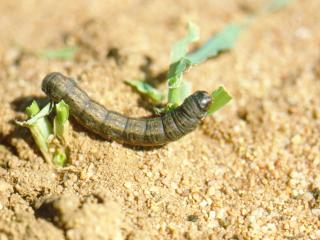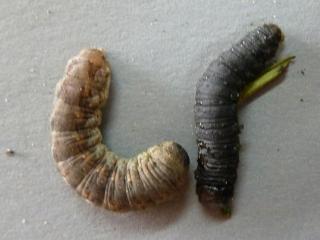Damage
All crop and pasture plants are attacked by cutworms. They are most damaging in autumn when large caterpillars (>20mm) transfer from summer and autumn weeds onto newly emerged crop seedlings. Whole paddocks of cereal or lupin or canola seedlings may be destroyed or severely thinned early in the season. Pastures may be attacked at any time during the season but damage usually goes unnoticed. Irrigated crops may be attacked at any time of the year.
When small, the caterpillars feed on the surface tissues of the tender foliage, but as they grow they assume their typical cutworm 'felling' activity. The surface feeding may be confused with damage caused by lucerne flea and the more serious damage may be attributed to webworm. However, webworm does not attack oats or broadleaved plants.
Description
Cutworm caterpillars are plump and smooth, growing to about 40mm long, but they usually cannot be seen as they hide under the soil or litter by day. Often they can be located by scratching the surface near damaged plants where they can be seen curled up in a defensive position.
Caterpillars with a pink tinge belong to the pink cutworm, Agrotis munda, which has caused widespread damage in agricultural areas north of Perth. The dark grey caterpillars of the bogong moth, Agrotis infusa, have been extremely damaging in most parts of the agricultural areas from time to time. Large numbers of patterned caterpillars belonging to different genera, Rictonis and Omphaletis, have also been found attacking cereals in agricultural areas.
Adult cutworms are stout-bodied moths with patterned wings. They fly very well and may be seen on window panes at night as they are attracted to lights.
Life cycle
Most of the eggs are laid on plant material near the soil surface. They are creamy-white when laid and hatch in three days or in several weeks depending on the temperature. The caterpillars emerging from the eggs grow with several moults until they are full size and then pupate in the ground. Moths emerge from those pupae. It may take one month or a whole year to complete the life-cycle depending on the species involved, and the weather.
Control
Cutworms are easily controlled by insecticides. They are most damaging in autumn when large caterpillars (>20mm) transfer from summer and autumn weeds onto newly emerged canola seedlings.
Biological control agents, including fly and wasp parasites, disease organisms and predatory beetles, continually reduce cutworm numbers but cannot be relied on to give adequate control.



